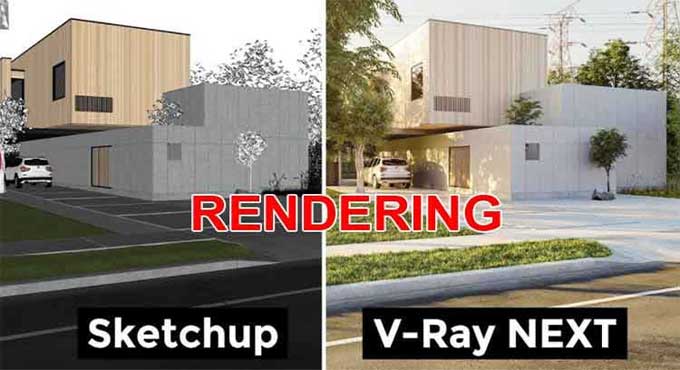How to render large files using V-Ray for SketchUp?

As designers, we often become so carried away with designing that we end up with a Sketchup file that is 300+ Megabytes and has over 2 Million edges, or at least that is the case with most of the beginners in SketchUp modeling.
This can cause problems as the file becomes too large and unwieldy to work with. It can also cause slowdowns in system performance and render times. To avoid this, it is important to be mindful of the number of edges in your model and optimize where necessary.
Though VRay is an excellent and powerful rendering service you do not want to make your models with rough edges and incomplete format. It not only makes your models complicated but also takes much longer time and a more complicated process to complete rendering.
That is why we are here to help you and others who have just got a little comfortable while designing your models and have not yet experienced the complications while rendering large files using V-Ray.
Tips to render large files using V-Ray for SketchUp
Before getting back into how you can render complicated or large SketchUp files you need to make sure that you are using the updated version of the V-ray Rendering Applications. As rendering complicated files could be hard on the outdated version of the application, it's better to remove the unresolved minor bugs with the new version of V-ray.
So here are some tips to render large file sizes using V-ray for SketchUp:-
Back faces must not be facing outward
Be sure that none of the rear sides of your models of walls, flooring, or even basic objects like glass windows are facing outward. There is a tool that was created just for this sort of use, and that tool may make your life a lot simpler, and its name is the Front Face application.
A few years ago, you could easily get it for free through Extension Warehouse, try to locate it. After choosing the tool, all you have to do is click on one back face and then hover over all the others to flip them.
Stop downloading not-required objects
Everyone loves 3D Warehouse because it has so many free items, but not everything you download is useful in simulations.
Downloading 3D Warehouse items requires a lot of time and effort, so it's important to be sure that the item is suitable for the project. Before downloading, it's important to check the reviews and ratings to make sure that the item is of good quality and can be used effectively.
Before importing anything into your model, examine all of the materials you downloaded in a separate SketchUp window to look for any issues that need to be corrected. Moreover, you might wish to remove or tidy up any excess hitchhiker detours or materials.
Lights and cameras are important
There is just one camera and one light in SketchUp. For a single model, a rendering engine can accommodate many alternative illumination and camera positions.
Depending on the amount of integration, you might be able to include these elements into a SketchUp model as you model, which would speed up the production of final renderings.
This would allow you to quickly adjust the lighting and camera angle to get the desired effect. Rendering engines can also simulate materials, textures, and environments in ways that SketchUp can't. This makes them a valuable tool for any SketchUp user.
Delete the excessive elements
It is similar to conducting a photo session to render a model. Prior to the output, you must spend time preparing your model.
When you are actively modeling, it might be agreeable to have excess parts or stray lines in your file, but when it comes time to render, only display what is necessary for the finished image.
To this end, it is important to take the time to optimize your model for rendering. This includes ensuring that the geometry is clean and that all the excess parts are removed. Additionally, the model should be lit and shaded properly to get the desired results from the render.
Always start rendering when the model is completely ready
Several renderers include a wide range of render-ready elements that you may insert into the model to increase the realism of your rendering, including water and grass as well as automobiles, trees, people, and other undesired objects that can drastically slow down a SketchUp rendering. So it is recommended to use 3D models which cannot be ignored at all.
To learn more, watch the following video tutorial.
Video Source: The Rendering Essentials
A render-ready asset can, however, be added to SketchUp as a low-poly proxy whose details are then rendered by the rendering engine as a high-poly asset.
With SketchUp, it is easy to choose your manner and type of rendering, and has integrations with over two dozen different rendering engines. A SketchUp Studio Membership includes full access to V-Ray 5 as well from SketchUp.
This offers the user a range of options to use, depending on the complexity of the project and the desired outcome. Users have the freedom to choose the rendering engine that best suits their needs. Additionally, the V-Ray 5 integration provides photorealistic renderings with advanced lighting and materials.



